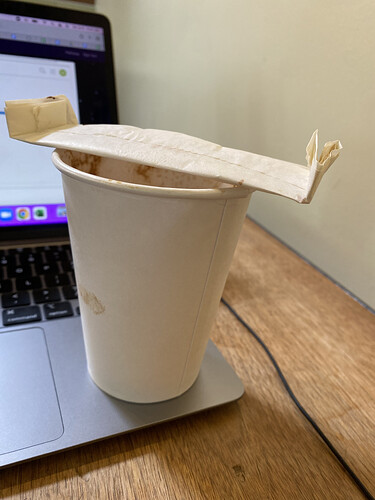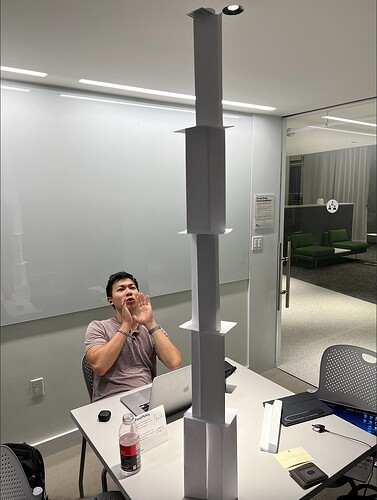After 20 minutes of trying to build a tower of objects, take a picture of your creation and share it in this discourse forum (or, if you don’t have a camera readily available, a description of the build will do). Create a new topic in this category for your post and respond to the following prompts:
-
Describe your process: what did you try, what worked and what didn’t work, what were you thinking as you tried these designs.
-
What did you learn about your materials, building towers, or the design process along the way?
Once you have finished, take a look at everyone else’s posts and respond to at least two colleagues: did they approach tower building in a similar way or differently? What can you learn from their tower building? Do you have any questions for them?
I am, in fact, at a coffee shop, so my access to materials is pretty limited. The materials available to me were: my empty coffee cup, the paper pouch my croissant came in (also empty, other than crumbs and bits of chocolate), my laptop and iPhone. The first design constraint was to prevent the crumbs from the pouch from spilling everywhere. I addressed that by folding it up in a way that contained all the crumbs. The second issue I came across was that it kept unfolding. I addressed this by folding up the two ends so that the structure was relatively stable. Then I needed to add height. I placed the folded up paper pouch on top of the cup. I then tried to find a way to place the resulting structure on top of my laptop, perhaps balancing it on the open screen. This was unsuccessful. I thought about adding height using my cellphone, but needed that to take a picture at the end. Ultimately, I did not involve any electronics in the production of my tower. Along the process, I found that paper, if folded along two dimensions rather than just one, is pretty stable.
I begin by thinking about the materials–what do i have many copies of that i could use as a building block for my tower? I originally tried to use my pencils, but had a hard time stacking them taller than one pencil length. Then, I thought about using papers, which I have many of because i am a pen and paper theorist at heart. I folded all the papers into three folds so they could be proped up as a triangle cylinder, and then stacked multiple layers of cylinders on top of each other to make the tower as a prototype. Then, i realized the tower is very unstable and sensitive to shaking or wind. (A friend is mimicking gusts of wind and earthquakes on the side) I then innovated by incorporating “knuckles” between layers and putting multiple cylinders in the bottom levels. I stopped when the tower was taller than me plus my arms length, and used a bottle cap as the marshmallow, although it feels stable enough to go higher. It’s resistant to a moderate amount of shaking and wind (as demonstrated by my friend attempting to sabotage my mission).
I think what’s important here is 1. thinking through the materials available, 2. being able to brainstorm ideas and build prototypes, and 3. being able to innovate and improve on the design.
I am in my living room, so I had access to many materials. I started by thinking about what would be the best and widest base. I wanted to start wide and go to narrow as I made it taller. I tried a few of my couch pillows before settling on the two flattest ones. As I built, I had to continue back and forth with different objects. A few times I had to move pieces to make sure the larger items went below. I had to stop and take the picture when my tower started to sway when I moved near and I didn’t want to break anything.
I learned that a base that is unstable causes a bit of stress. Additionally, I did not go for much in terms of design. I simply thought practical and threw it all together. I knew that starting big would work as a design concept.
I appreciate how you attempted to make something taller with what you had. I am sorry you did not have much to work with, but it turned out more stable than mine!
I like that you had a clear design to yours and thought about stability as well. Iran into stability issues and just kept going with it. I appreciate that you took time to improve. I powered through and tried not to move too much.
I looked around my immediate area and tried to find a suitable building block that would not be wholly inconvenient to reset. To my right were stacks of cassettes destined for a proper shelf that is yet to be built (you can see the dusty outline of their current home). I could have perhaps disassembled some speakers and received additional stable height, but I didn’t truly want to have to reconnect everything.
My consistent internal monologue was, “you need to finish that shelf so you can actually listen to some of these buried in the stack.” Additionally, I hit a few points of frustration where I had let nonstandard cassette packaging (DIY cardstock packaging, broken shells, etc.) interfere with homogenous stack. I didn’t want to clean up a ton of busted cassette cases, so I stayed pretty conservative in my methods. A bootleg Frida Kahlo lego stood in for a marshmallow.
I really enjoyed how radically different the other three examples are from what I ended up with: the care placed to minimize mess, the ingenuity of paper construction, the wide number of different objects. I appreciated seeing everyone’s work!



